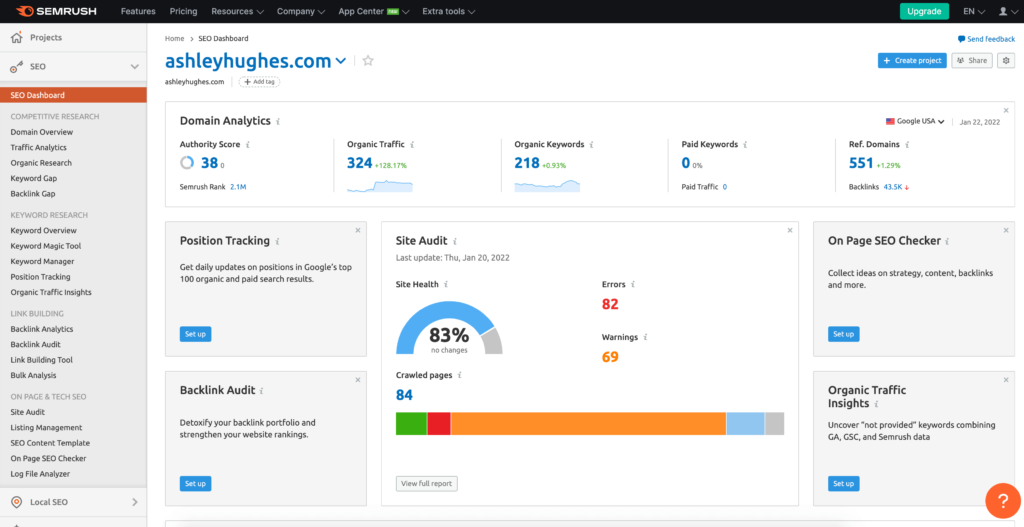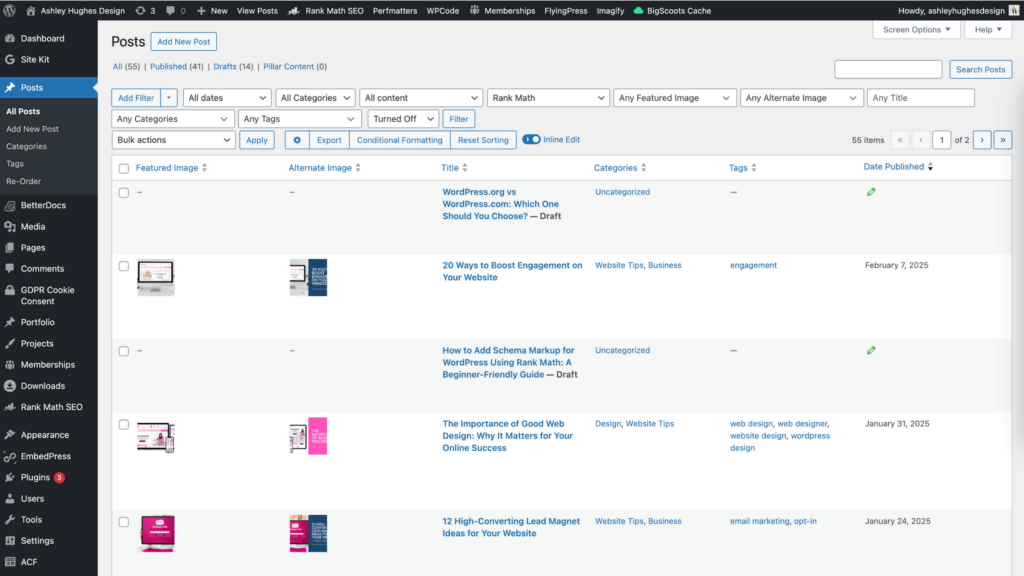Share this Post

So, you’ve been working on your website’s, but you have no idea if that work has paid off at all. Here’s how you can do a quick SEO analysis of your website. I’ll show you a few tools to use and what to do with those reports.
If you have no idea where you should even start with SEO, then take a look at this post.
Table of Contents
Let’s take this step by step:
1. Run An SEO Analysis of Your Website
It’s always smart to pull SEO reports from two or more platforms (unless you have a pro plan for a service then those are very comprehensive) . Running multiples allows you to see issues that another platform has not reported. Each platform executes the tests in slightly different ways, so this approach of multiple reports gives you the most comprehensive check. Personally, I always test on Google Lighthouse and Ubersuggest.
Here are 4 platforms that will allow you to run a free SEO analysis of your website:
***Note: You will always get different scores for each platform (like mine below). Just be prepared. Again, they all run their tests differently and don’t all measure or track the same metrics.
Google Lighthouse
This is always the first test I run. Why? Because if I’m wanting to rank higher on Google, then I want to know what Google thinks I can improve upon. This one is super easy to run, but you DO have to have Chrome.
- Open your site in an incognito window (right click on Chrome icon and select “New Incognito Window”)
- Right click anywhere on your page.
- Click “Inspect.”
- Your screen will split and you’ll see a whole bunch of code to the right. In the top little menu bar of that area you’ll see a >> icon. Hit that and select “Lighthouse.”
- Generate a report for your site (I always choose Desktop and SEO) if I’m just wanting to check out SEO. You can certainly leave all the other metrics selected if you want.
- Let it run and then check out your results.
- Look at the things in red. Those are the things you want to try and resolve or improve if possible.
Ubersuggest
I’ve mentioned this site before. It’s my favorite. You’re allowed a few searches per day, so you can run a site audit without paying for a plan. However, they have a free plan that would give you access to some great data. Here’s how to run an SEO analysis of your website:
- Go to https://neilpatel.com/ubersuggest/
- Enter your domain into the search bar.
- The results will give you an overall score, SEO issues, general traffic data, backlinks, and ranking keywords.
- Pay attention to the SEO issues and try to fix or improve those.
SEMRush

SEMRush has a site audit tool that is very thorough, but might feel a little overwhelming if you’re new to analyzing your site. It’s a free option though, so check it out.
- Go to https://www.semrush.com/siteaudit/
- Enter your domain into the search bar.
- The results will give you tons of data.
- Pay attention to the top issues (at the bottom of the graph area) and check out the errors and warnings.
Be warned that SEMRush always gives me anxiety when I run my site. It gives me way more “things to fix” than Google or Ubersuggest. Love it, but also hate it. Use with caution or a glass of wine.
SEO Site Checkup
This tool isn’t one I use often, but it does work great and it’s free! I do like how it presents the results. It gives you very specific issues and makes them easy to understand.
- Go to https://seositecheckup.com/
- Enter your domain into the search bar.
- The results will give you a lot of great data, with the most important at the top.
- Pay attention to the “issues to fix” and try to
2. Make the red things a priority and schedule time to work on them.
After you perform an SEO analysis of your site, it’s time to take action. All of these platforms use color coding to show you what issues require attention. Some errors or warnings hive a higher priority than others. You’ll want to tackle those red issues first! Most SEO checkers out there will typically have a link or a tooltip next to the error to show you how to fix or improve issues. I always start out with Google Lighthouse and fix those first. Then I move onto the more detailed reports from Ubersuggest (or whatever platform you use).
The most important thing to remember? Take it slow. Don’t feel like you have to fix all of the red things in a single day. Ideally you wouldn’t have any red, but even SEO “gurus” have errors. The most important thing is that your website is crawlable (meaning Google knows it exists and can crawl and navigate through all your links). Open up your calendar or planner and write down “fix seo errors” once a day, week, month, whatever you have time for. Bottom line? Make time for it.
I recommend running an SEO analysis of your website about once every couple months (or longer if you don’t add much content). That way you can stay on top of things and fix any issues that arise.
No Clue? If certain tasks feel impossible or confusing, then reach out to a WordPress designer or developer! Chance are we can help you out.

Ashley Hughes
I design beautiful branding and graphics, build custom WordPress websites, and handle all the technical stuff so that you can focus on what’s important to your creative business… and stop doing all the things.



















Leave a Reply